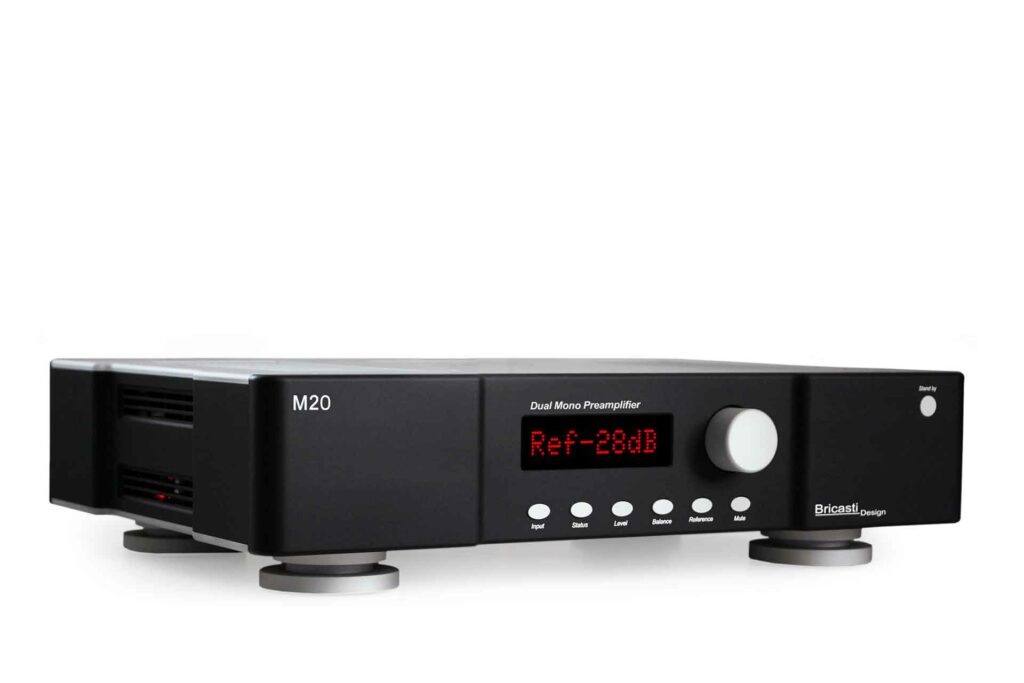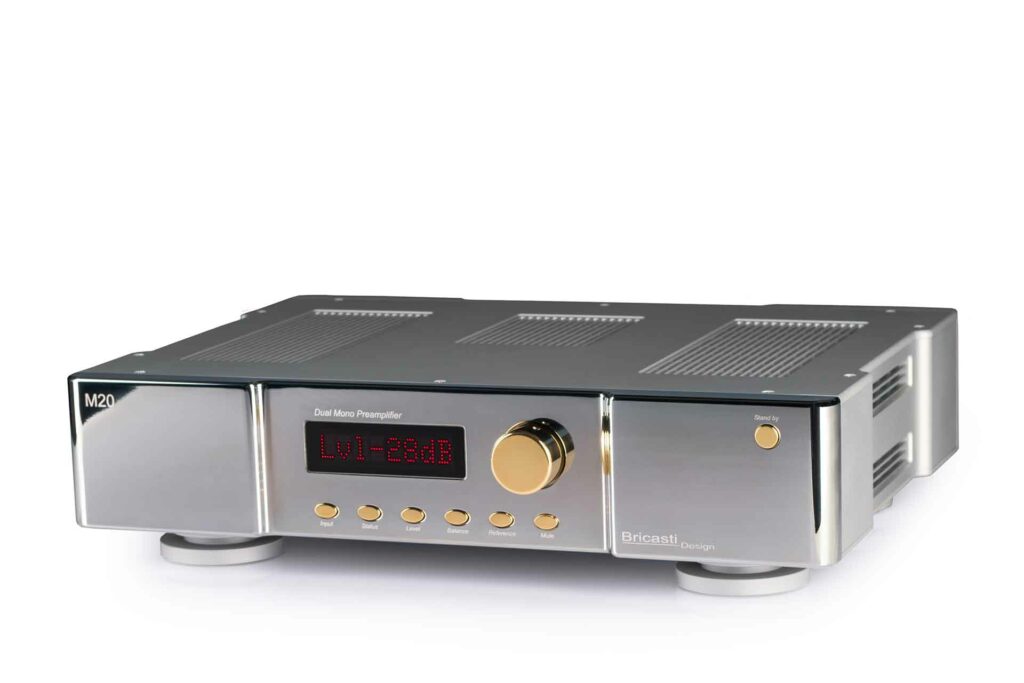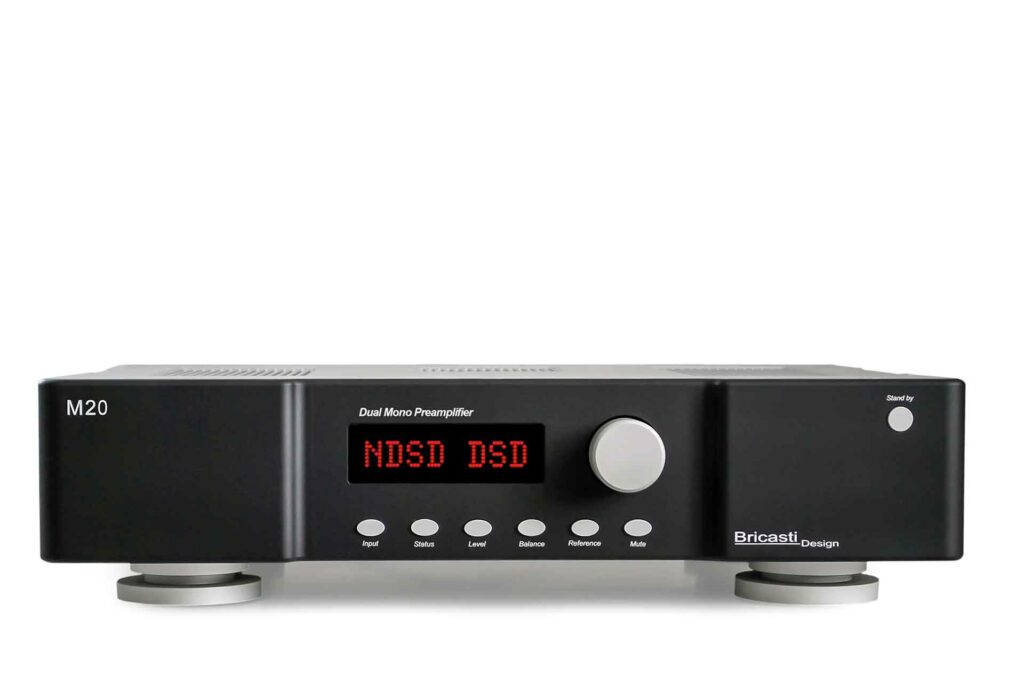Given that many of today’s audiophile DACs, phono stages, and even many modern audiophile amplifiers have their own internal volume controls, it may not be clear why you would ever want to integrate a preamplifier into your modern audiophile music system. In my view, the attenuators built into DACs and so forth are often detrimental to the quality of reproduced sound. Whether a digital source is dropping bits to attenuate the volume (which raises the noise floor) or an amplifier has a simple dual-potentiometer/stepped-resistor ladder, there is signal loss. When you are spending many thousands of dollars per component (sometimes tens of thousands) I am urging you to keep things pure and to go a little old-school for the best performance in general terms.
At $12,500, the Bricasti M20 stereo preamp is at the pricier end of its category, even if you limit that category to U.S.-made audiophile gear. Bricasti is considered, despite its significant cost, to compete with the absolute best-of-the-best audiophile electronics from lauded companies around the world, many of which cost much, much more. It seems crazy to call a $12,500 stereo preamp a “value,” but hang in there with me here because there is an explanation.

What Makes the Bricasti M20 Stereo Preamp So Special?
- The Bricasti M20 is a preamp with dual-mono topography, which means each channel of the sound is handled independently, from the power supply, through the proprietary R-2R ladder attenuator. To further ensure the signal is preserved, the M20 includes a separate, discrete power supply for the digital processing and controls. The sum of this technology is a (reportedly) world-class THD+N of 0.0007 percent, and crosstalk of less than -120dB, which is impressive.
- On the back of the Bricasti M20 stereo preamp, there are three discreet analog outputs. Why do you care? Because with the Bricasti M20, you have the ability to use one amp, bi-amp, or even tri-amp your speakers without compromise. Each output on the M20 stereo preamp has its own independent buffer amplifier, which allows these more sophisticated system configurations to remain transparent as your system develops down the road.
- Each input on the Bricasti M20 stereo preamp can be customized, including level offsets. This very useful feature allows the volume to be matched from source to source. This makes A/B comparisons using the Bricasti M20 stereo preamp much more realistic and accurate.
- The Bricasti M20 is built with very premium internal components. This statement extends far beyond the Vishay foil resistors and other precision-matched electronics. Even the circuit boards are made from a ceramic based material with superb dielectric properties. “Better dielectric material” means less current leakage from components resulting in lower noise and better signal preservation.
- The Bricasti M20 is proudly made in the United States. Bricasti manufactures their chassis out of solid aluminum billet in Shirly, Massachusetts. All board assembly is done on the East Coast and final assembly/testing of each M20 is performed in-house with painstaking detail.
Why Should You Care About the Bricasti M20 Stereo Preamp?
In the world of stereo preamps, digital volume controls can fail to deliver full output and damage your loudspeakers. More traditional potentiometers wear out, lose their channel-to-channel integrity, and get scratchy. Stepped resistor volume controls have mechanical contacts with limited volume steps. Many premium preamps contain electro-mechanical (EM) relays to switch resistors for volume control. EM Relays add a mechanical connection that increases distortion. The Bricasti M20 does not suffer any of these ills due to its distinctive volume control and fully discreet, solid-state design.
The ideal preamplifier acts as a tool that can provide the perfect volume for a listening experience but does not affect the signal that is selected from any given source. The Bricasti M20 does this better than any preamplifier I have heard from the beginning of my journey in 1993, to now. You can spend more money (much more money) and not find better source and volume control than with the M20 stereo preamp.

Some Things You Might Not Like About the Bricasti M20 Stereo Preamp
- The sound of the Bricasti M20 preamp is on the sweet side of neutral to my ears.
- Where the Bricasti M20 stereo preamp has a significant advantage is when it is paired with a supreme source like the Bricasti M1 DAC. It becomes far more advantageous to have the Bricasti M1 DAC at full output in order to have its full digital capability and let the M20 handle the volume control. This advantage checks out with any premium source from phono to an SACD player and beyond.
- There is a lot of hard selling of technologies that are re-imaginations of the days of audiophile yore. These “new-age vintage” pieces can cost a whole lot of money and the neato factor can get old quick when they just do not perform as well. For those looking for top-tier performance, it can be difficult to sort the wheat from the chaff when the audio media is constantly bombarding everyone with fancy words for “It is good but not great.”
Listening to the Bricasti M20 Stereo Preamp…
For a few years before the Bricasti M20 found a spot in my listening rig, I was using the Bricasti Design M1 DAC without a preamplifier. The Bricasti M1 DAC (when used as a preamp) has 32 bit-depth and a noise floor that is so low that it is difficult to measure. On the surface there seemed to be no outright need for a preamp since 95 percent of my listening is digital.
The Bricasti M20 preamp provides a damn-near transparent window into the music. This means it passes the signal of the M1 DAC with such little affect that it sounds like the M20 is not even in the signal path. With one large exception: superb recordings. This is where it gets interesting.
A good test for the Bricasti M20 stereo preamp is “Jack Nimble” by Lady of the Sunshine. Coming off the 2010 album Smoking Gun (from CD), the Australian Duo of Angus and Julia stone (now producing albums under their own name) sets the Alternative/Indie bar with a stellar recording, complex music, and deep musical passion. It is recordings like “Jack Nimble” where I found the Bricasti M20 preamplifier is simply additive. Having the M1 DAC at full output means no bit-depth loss. Since the M20 acts as a window I found myself able to listen at my normal listening levels, yet have more detail and a wider soundstage than with the M1 DAC alone. This is unique to the M20. Every preamplifier I have heard paired with the M1 DAC has only gotten in its way, and was detrimental to the musical experience. The M20 did sweeten up the tight harmonies a little, however this was far more of a character embellishment than a detriment.
Bruno Mars Released An Evening With Silk Sonic in 2021 (from CD), which includes drummer Anderson Paak as well as Bootsy Collins on bass. I believe Bruno needs no introduction, but this newer recording is a true gem for audiophiles looking for some more modern recordings to light up your system with. Bruno Mars grew up listening to 1950s doo-wop, was an Elvis impersonator, and draws inspiration heavily from the late Michael Jackson. His pop recordings are well recorded, and his music is full of soul. “Leave the Door Open” is no exception. A well-orchestrated piece of music featuring Anderson Paak “Leave the Door Open” invokes feelings of a bubbly hot-tub, silk robes, and sex appeal. Not since Barry White has a song been so on-the-nose for genre I would like to invent called “Hot Tub Rock.” The M20, again acts as a clear window into the music.
The breathy background vocals and percussive accents have more space than with the M1 alone. The effortlessness of the music is there in whole, and nothing is missing on any level that would make this musical experience less.
Does The Bricasti M20 Preamp Have Any Resale Value?
Frankly, it is difficult to find used Bricasti gear anywhere, so it’s hard to be sure. When you do find a Bricasti piece on the secondhand market, you will find it holds its value extremely well. It is a newer brand compared to the most lofty and time-tested electronics companies, but audiophiles know and they snap it up. You should expect to have very respectable resale from any Bricasti investment these days.

Who Is the Competition For The Bricasti M20 Stereo Preamp?
The first preamp that comes to mind would be the Audio Research Reference 6SE stereo preamp at $17,000, which is a pretty big increase in price from the Bricasti M20. Audio Research needs no introduction to the audiophile world, as they are about as blue-chip as it comes. On paper, the Bricasti looks a little more robust, but it is often unfair to take on tube products on a spec-only “paper debate.” Tubes often have more of a “sound” than equally good solid-state electronics. If you like the sound, as many rightfully do, then you know where to invest.
The Mark Levinson No. 5206 stereo preamp is price competitive to the M20 at $11,000. It also includes a DAC and phono stage, as many high-end audiophile preamplifiers do these days. While the No. 5206 is a dual-mono design, its distortion is orders of magnitude greater than the M20 on paper. Unfortunately, this is what happens when you cram everything that should be separated into a single box at the five-figure level. I have not heard the No.5206 extensively, however what I heard was compelling and I look forward to digging in a little deeper.
Trinnov’s Amethyst Stereo Preamp at $11,000 (in silver) is perhaps one of the most compelling options out there in that the Trinnov goes about bringing audio nirvana via a whole other angle – via the world’s best room correction system to a high end stereo preamp. Make no mistake, the Trinnov Amethyst is a killer stereo preamp/DAC before they put in their game-changing room correction into the mix. Room acoustics are a gigantic issue for most audiophiles, even with big-budget system, and the Trinnov solves epic issues in ways never seen before. Old fart audiophiles are falling over dead at this comment but it is true. Trinnov also offers a digital room correction component called the ST2 pro for about $4,995 which allows you to bring the best of their world to existing systems.
Final Thoughts on the Bricasti M20 Preamplifier
The Bricasti M20 preamp is a sonically clear window into music that adds useful versatility to any high-end audiophile system. The M20 is no-nonsense audiophile solution. The handful of features included in the Bricasti M20 stereo preamp are all useful and purposeful, which will appeal to audiophiles with penchant for minimalism.
While pricy in the big picture, the Bricasti M20 stereo preamp represents a value in high-end audio that I would compare in performance to stereo preamps at literally any high-end price point. The M20 isn’t low-cost by any measure, but in my view, it can hold its own against preamps from the best of the best electronics from every corner of the world for a fraction of the price, and because of that I not only love this preamp but I will go so far as to call it a tremendous high-end audio value.

